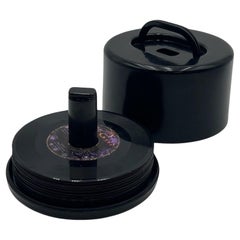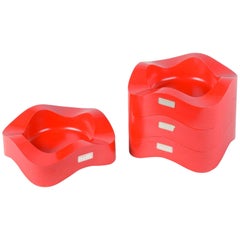Kartell Boxes
The Italian design giant Kartell transformed plastic from the stuff of humble household goods into a staple of luxury design in the 1960s. Founded in Milan by Italian chemical engineer Giulio Castelli (1920–2006) and his wife Anna Ferrieri (1918–2006), Kartell began as an industrial design firm, producing useful items like ski racks for automobiles and laboratory equipment designed to replace breakable glass with sturdy plastic. Even as companies like Olivetti and Vespa were making Italian design popular in the 1950s, typewriters and scooters were relatively costly, and Castelli and Ferrieri wanted to provide Italian consumers with affordable, stylish goods.
They launched a housewares division of Kartell in 1953, making lighting fixtures and kitchen tools and accessories from colorful molded plastic. Consumers in the postwar era were initially skeptical of plastic goods, but their affordability and infinite range of styles and hues eventually won devotees. Tupperware parties in the United States made plastic storage containers ubiquitous in postwar homes, and Kartell’s ingenious designs for juicers, dustpans, and dish racks conquered Europe. Kartell designer Gino Colombini was responsible for many of these early products, and his design for the KS 1146 Bucket won the Compasso d’Oro prize in 1955.
Buoyed by its success in the home goods market, Kartell introduced its Habitat division in 1963. Designers Marco Zanuso and Richard Sapper created the K1340 (later called the K 4999) children’s chair that year, and families enjoyed their bright colors and light weight, which made them easy for kids to pick up and move. In 1965, Joe Colombo (1924–78) created one of Kartell’s few pieces of non-plastic furniture, the 4801 chair, which sits low to the ground and comprised of just three curved pieces of plywood. (In 2012, Kartell reissued the chair in plastic.) Colombo followed up on the success of the 4801 with the iconic 4867 Universal Chair in 1967, which, like Verner Panton’s S chair, is made from a single piece of plastic. The colorful, stackable injection-molded chair was an instant classic. That same year, Kartell introduced Colombo’s KD27 table lamp. Ferrierei’s cylindrical 4966 Componibili storage module debuted in 1969.
Kartell achieved international recognition for its innovative work in 1972, when a landmark exhibition curated by Emilio Ambasz called “Italy: The New Domestic Landscape” opened at New York’s Museum of Modern Art. That show introduced American audiences to the work of designers such as Gaetano Pesce; Ettore Sottsass, founder of the Memphis Group; and the firms Archizoom and Superstudio (both firms were among Italy's Radical design groups) — all of whom were using wit, humor and unorthodox materials to create a bracingly original interior aesthetic.
Castelli and Ferrieri sold Kartell to Claudio Luti, their son-in-law, in 1988, and since then, Luti has expanded the company’s roster of designers.
Kartell produced Ron Arad’s Bookworm wall shelf in 1994, and Philippe Starck’s La Marie chair in 1998. More recently, Kartell has collaborated with the Japanese collective Nendo, Spanish architect Patricia Urquiola and glass designer Tokujin Yoshioka, among many others. Kartell classics can be found in museums around the world, including MoMA, the Victoria and Albert Museum and the Cooper Hewitt, Smithsonian Design Museum. In 1999, Claudio Luti established the Museo Kartell to tell the company’s story, through key objects from its innovative and colorful history.
Find vintage Kartell tables, seating, table lamps and other furniture on 1stDibs.
1960s Italian Space Age Vintage Kartell Boxes
Plastic
1970s Italian Space Age Vintage Kartell Boxes
Plastic
1960s Italian Mid-Century Modern Vintage Kartell Boxes
Metal
1960s Czech Mid-Century Modern Vintage Kartell Boxes
Ceramic
1960s German Space Age Vintage Kartell Boxes
Plastic
1960s Danish Scandinavian Modern Vintage Kartell Boxes
Rosewood
1960s Vintage Kartell Boxes
Alabaster
1960s Chinese Chinese Chippendale Vintage Kartell Boxes
Brass
Mid-20th Century European Industrial Kartell Boxes
Metal
21st Century and Contemporary Italian Modern Kartell Boxes
Plastic
Mid-20th Century American Industrial Kartell Boxes
Leather
Early 20th Century Art Deco Kartell Boxes
Silver Plate
1960s French Space Age Vintage Kartell Boxes
Silver Plate, Brass
1970s Italian Mid-Century Modern Vintage Kartell Boxes
Plastic
1960s Italian Mid-Century Modern Vintage Kartell Boxes
Ceramic
Kartell boxes for sale on 1stDibs.
Creators Similar to Kartell
- What is the history of Kartell?1 Answer1stDibs ExpertFebruary 21, 2024The history of Kartell starts with an Italian chemical engineer named Giulio Castelli and his wife, Anna Ferrieri. The couple founded Kartell in Milan as an industrial design firm, producing utilitarian items like ski racks for automobiles and laboratory equipment designed to replace breakable glass with sturdy plastic. Even as companies like Olivetti and Vespa were making Italian design popular in the 1950s, typewriters and scooters were relatively costly, and Castelli and Ferrieri wanted to provide Italian consumers with affordable, stylish goods. They launched a housewares division of Kartell in 1953, making lighting fixtures and kitchen tools and accessories from colorful molded plastic. Buoyed by its success in the home goods market, Kartell introduced its Habitat division in 1963. Kartell achieved international recognition for its innovative work in 1972, when a landmark exhibition curated by Emilio Ambasz called "Italy: The New Domestic Landscape" opened at New York's Museum of Modern Art. Castelli and Ferrieri sold Kartell to Claudio Luti, their son-in-law, in 1988, and since then, Luti has expanded the company's roster of designers. On 1stDibs, explore a large selection of Kartell furniture.
- What is Kartell known for?1 Answer1stDibs ExpertMarch 22, 2022Kartell is known largely for producing contemporary furniture out of plastic. The Italian company, founded in 1949, helped elevate the material, proving that it was suitable for designer furniture. You can find a collection of Kartell furniture and decorative objects on 1stDibs.
- 1stDibs ExpertMarch 25, 2024How you clean Kartell plastic depends on the piece. Often, the best way to clean plastic furniture is with lukewarm water and mild dish soap. However, recommended cleaning methods vary. For the best results, refer to the manufacturer's care instructions that accompany your furniture. Shop a collection of Kartell furniture on 1stDibs.
- 1stDibs ExpertApril 5, 2022Kartell Louis Ghost chairs are made of lucite. Designed by Phillipe Starck for Kartell in 2002, this clear chair is crafted from a single piece of plastic, making it a beautifully elegant piece. On 1stDibs, find a range of authentic Kartell Ghost chairs from top sellers.




